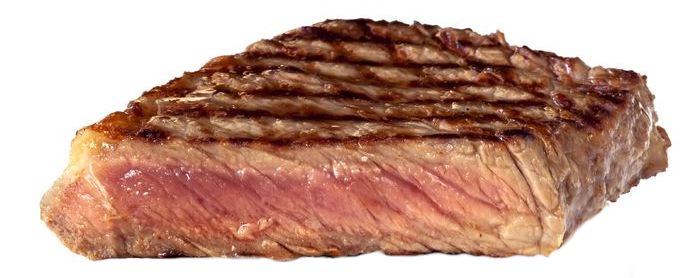Dicey Instructions
I keep seeing cooking references saying that you need to dice your vegetables to a uniform size in order for them too cook evenly. Is that true?
-Fred
In a word, no. There may be an argument made for an even dice for aesthetic reasons -- a lovely rice pilaf with nice uniform cubes of veggies shows attention to detail and is a thing of art -- but from a strictly scientific point of view, when it comes to the usual carrots, onions, potatoes, etc, this is another cooking myth that needs to be put to rest.
If you have been cooking for a while, you have likely already seen the any number of pictures of a steak, fresh off the heat cut across the middle. Stay with me for a moment. We will get back to vegetables soon.  The steak picture usually shows something approximately rectangular in shape with a smaller rectangle with rounded corners of less cooked meat in the center, something like the image to the above. Notice that the thickness of the cooked area on all four sides is close to the same. Why? Because heat travels through a uniform solid at a constant, linear rate regardless of how thick the solid is. It would be the same for a strip steak, a thick, juicy tenderloin or a 20 pound roast. Assuming they all start at the same temperature and at a uniform temperature throughout, with the same heat applied to the outside surface, after the same amount of time, all would have the same temperature gradient over the same distance from the outside edge until each is cooked through.
The steak picture usually shows something approximately rectangular in shape with a smaller rectangle with rounded corners of less cooked meat in the center, something like the image to the above. Notice that the thickness of the cooked area on all four sides is close to the same. Why? Because heat travels through a uniform solid at a constant, linear rate regardless of how thick the solid is. It would be the same for a strip steak, a thick, juicy tenderloin or a 20 pound roast. Assuming they all start at the same temperature and at a uniform temperature throughout, with the same heat applied to the outside surface, after the same amount of time, all would have the same temperature gradient over the same distance from the outside edge until each is cooked through.
Then what is going on at the corners? Why is the inside shape rounded instead of square? The reason is that the heat at the corners is penetrating from two directions so it cooks faster than the middle. Wait long enough and the inside shape will become more oval, and then disappear entirely as the two closest faces meet. The determining factor for when they meet is the thickness of the cut. That's why when you see instructions for cooking a steak, it tells you how long to cook for a recommended thickness, not for the total weight of the steak.
OK, back to vegetables. The same thing applies here. If you cut a carrot into ½ slices or ½ cubes, they will cook to the same degree of doneness in the same length of time, assuming the heat is the same and that it is applied uniformly to the surfaces, since it is only the narrowest dimension really counts. You can go ahead and chop and dice them however you want. Put fluted edges on, make fancy turned vegetables, whatever strikes your fancy. As long as the shortest dimension is the same for all of them, they will all cook at the same time.
How about when you are using several different vegetables, say carrot, celery and onion, the classic mirepoix? What counts is how fast heat is conducted through the material. In general foods of the same density (weight/volume) and moisture content will cook at close to the same rate. Carrots are a little more dense than onion and celery, but likely not enough to make a large difference. Throw in turnips, potatoes and most other vegetables. Still the same deal. As long as the thinnest dimension is the same, they will cook in the close to same amount of time.
Then why be so fussy? Because cooking is both art and science, and because we eat with our eyes first. Appearance counts as much as technique. So even if science says you don't have to make perfect diced vegetables all of the time, sometimes you might really want to.
